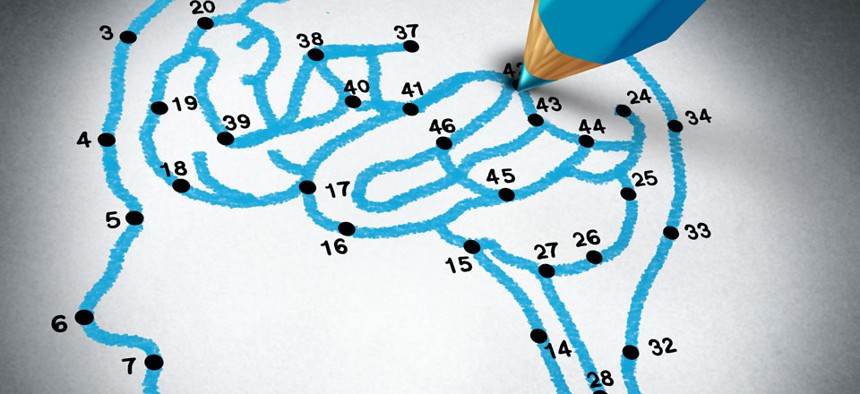Prepare to Be Shocked

Lightspring/Shutterstock.com
Four predictions about how brain stimulation will make us smarter
Several years ago, the Defense Advanced Research Projects Agency got wind of a technique called transcranial direct-current stimulation, or tDCS, which promised something extraordinary: a way to increase people’s performance in various capacities, from motor skills (in the case of recovering stroke patients) to language learning, all by stimulating their brains with electrical current. The simplest tDCS rigs are little more than nine-volt batteries hooked up to sponges embedded with metal and taped to a person’s scalp.
It’s only a short logical jump from the preceding applications to other potential uses of tDCS. What if, say, soldiers could be trained faster by hooking their heads up to a battery?
This is the kind of question DARPA was created to ask. So the agency awarded a grant to researchers at the University of New Mexico to test the hypothesis. They took a virtual-reality combat-training environment called Darwars Ambush—basically, a video game the military uses to train soldiers to respond to various situations—and captured still images. Then they Photoshopped in pictures of suspicious characters and partially concealed bombs. Subjects were shown the resulting tableaus, and were asked to decide very quickly whether each scene included signs of danger. The first round of participants did all this inside an fMRI machine, which identified roughly the parts of their brains that were working hardest as they looked for threats. Then the researchers repeated the exercise with 100 new subjects, this time sticking electrodes over the areas of the brain that had been identified in the fMRI experiment, and ran two milliamps of current (nothing dangerous) to half of the subjects as they examined the images. The remaining subjects—the control group—got only a minuscule amount of current. Under certain conditions, subjects receiving the full dose of current outperformed the others by a factor of two. And they performed especially well on tests administered an hour after training, indicating that what they’d learned was sticking. Simply put, running positive electrical current to the scalp was making people learn faster.
Dozens of other studies have turned up additional evidence that brain stimulation can improve performance on specific tasks. In some cases, the gains are small—maybe 10 or 20 percent—and in others they are large, as in theDARPA study. Vince Clark, a University of New Mexico psychology professor who was involved with the DARPA work, told me that he’d tried every data-crunching tactic he could think of to explain away the effect of tDCS. “But it’s all there. It’s all real,” Clark said. “I keep trying to get rid of it, and it doesn’t go away.”
Now the intelligence-agency version of DARPA, known as IARPA, has created a program that will look at whether brain stimulation might be combined with exercise, nutrition, and games to even more dramatically enhance human performance. As Raja Parasuraman, a George Mason University psychology professor who is advising an IARPA team, puts it, “The end goal is to improve fluid intelligence—that is, to make people smarter.”
Whether or not IARPA finds a way to make spies smarter, the field of brain stimulation stands to shift our understanding of the neural structures and processes that underpin intelligence. Here, based on conversations with several neuroscientists on the cutting edge of the field, are four guesses about where all this might be headed.
1. Brain stimulation will expand our understanding of the brain-mind connection.
The neural mechanisms of brain stimulation are just beginning to be understood, through work by Michael A. Nitsche and Walter Paulus at the University of Göttingen and by Marom Bikson at the City College of New York. Their findings suggest that adding current to the brain increases the plasticity of neurons, making it easier for them to form new connections. We don’t imagine our brains being so mechanistic. To fix a heart with simple plumbing techniques or to reset a bone is one thing. But you’re not supposed to literally flip an electrical switch and get better at spotting Waldo or learning Swahili, are you? And if flipping a switch does work, how will that affect our ideas about intelligence and selfhood?
Even if juicing the brain doesn’t magically increase IQ scores, it may temporarily and substantially improve performance on certain constituent tasks of intelligence, like memory retrieval and cognitive control. This in itself will pose significant ethical challenges, some of which echo dilemmas already being raised by “neuroenhancement” drugs like Provigil. Workers doing cognitively demanding tasks—air-traffic controllers, physicists, live-radio hosts—could find themselves in the same position as cyclists, weight lifters, and baseball players. They’ll either be surpassed by those willing to augment their natural abilities, or they’ll have to augment themselves.
2. DIY brain stimulation will be popular—and risky.
As word of research findings has spread, do-it-yourselfers on Reddit and elsewhere have traded tips on building simple rigs and where to place electrodes for particular effects. Researchers like the Wright State neuroscientist Michael Weisend have in turn gone on DIY podcasts to warn them off. There’s so much we don’t know. Is neurostimulation safe over long periods of time? Will we become addicted to it? Some scientists, like Stanford’s Teresa Iuculano and Oxford’s Roi Cohen Kadosh, warn that cognitive enhancement through electrical stimulation may “occur at the expense of other cognitive functions.” For example, when Iuculano and Kadosh applied electrical stimulation to subjects who were learning a code that paired various numbers with symbols, the test group memorized the symbols faster than the control group did. But they were slower when it came time to actually use the symbols to do arithmetic. Maybe thinking will prove to be a zero-sum game: we cannot add to our mental powers without also subtracting from them.
3. Electrical stimulation is just the beginning.
Scientists across the country are becoming interested in how other types of electromagnetic radiation might affect the brain. Some are looking at using alternating current at different frequencies, magnetic energy, ultrasound, even different types of sonic noise. There appear to be many ways of exciting the brain’s circuitry with various energetic technologies, but basic research is only in its infancy. “It’s so early,” Clark told me. “It’s very empirical now—see an effect and play with it.”
As we learn more about our neurons’ wiring, through efforts like President Obama’s BRAIN Initiative—a huge, multiagency attempt to map the brain—we may become better able to deliver energy to exactly the right spots, as opposed to bathing big portions of the brain in current or ultrasound. Early research suggests that such targeting could mean the difference between modest improvements and the startling DARPA results. It’s not hard to imagine a plethora of treatments tailored to specific types of learning, cognition, or mood—a bit of current here to boost working memory, some there to help with linguistic fluency, a dash of ultrasound to improve one’s sense of well-being.
4. The most important application may be clinical treatment.
City College’s Bikson worries that an emphasis on cognitive enhancement could overshadow therapies for the sick, which he sees as the more promising application of this technology. In his view, do-it-yourself tDCS is a sideshow—clinical tDCS could be used to treat people suffering from epilepsy, migraines, stroke damage, and depression. “The science and early medical trials suggest tDCS can have as large an impact as drugs and specifically treat those who have failed to respond to drugs,” he told me. “tDCS researchers go to work every day knowing the long-term goal is to reduce human suffering on a transformative scale.” To that end, many of them would like to see clinical trials test tDCS against leading drug therapies. “Hopefully the National Institutes of Health will do that,” Parasuraman, the George Mason professor, said. “I’d like to see straightforward, side-by-side competition between tDCS and antidepressants. May the best thing win.”
A Brief Chronicle of Cognitive Enhancement
500 b.c.: Ancient Greek scholars wear rosemary in their hair, believing it to boost memory.
1886: John Pemberton formulates the original Coca-Cola, with cocaine and caffeine. It’s advertised as a “brain tonic.”
1955: The FDA licenses methylphenidate—a k a Ritalin—for treating “hyperactivity.”
1997: Julie Aigner-Clark launches Baby Einstein, a line of products claiming to “facilitate the development of the brain in infants.”
1998: Provigil hits the U.S. market.
2005: Lumosity, a San Francisco company devoted to online “brain training,” is founded.
2020: A tDCS company starts an SAT-prep service for high-school students.
(Image via Lightspring/Shutterstock.com)
NEXT STORY: FAA moves on drone test and research sites






